Southbound Thru-Hikers: The Appalachian Trail Hiker Survey
Since I finished my Appalachian Trail (AT) thru-hike in 2014, I’ve been working with The Trek to survey thru-hikers each year. Most of the hikers who take our surveys are northbounders (or NOBOs), since most AT hikers walk from Georgia to Maine. Hiking southbound (or SOBO) from Maine to Georgia is less common (although somewhat ironically, the creators of the AT assumed more people would hike southbound, which is why signs and AT-branded items usually read “Maine to Georgia”). It is even less common to flip-flop, or hike from someplace in the middle to one end, then the middle to the other end, or an end to the middle.
Because SOBO and flip-flop hikes are less common, it’s taken several years of surveying thru-hikers to have enough data to look at trends among SOBOs specifically. (And we still don’t have enough data to look at flip-flop hikes). So I re-analyzed data we had from previous surveys to look at ways southbounders’ gear choices, favorite sections, and most difficult sections might be different from those of northbounders. I was wrong in my guesses about some of these trends—probably because I hiked NOBO! For details and graphs, keep reading—otherwise skip to the TL;DR at the end.
The Sample of Hikers
For boring math reasons, it would be problematic to compare a small sample of southbounders to many, many more northbounders. So instead, I did matched comparisons. This means I found a northbounder to compare each southbounder to who had thru-hiked the same year, had the same amount of prior hiking experience, was the same sex, and was a similar age (most were within a year of each other’s age). In total, we have surveyed 42 southbounders: 10 from our 2019 survey, 7 from our 2018 survey, 20 from our 2017 survey, and 5 from our 2016 survey. For the first surveys in 2014 and 2015, we unfortunately did not ask about the direction of the hike.
Altogether, there were 42 matched pairs of NOBOs and SOBOS, or 84 hikers total in the survey. So this means that for all comparisons of northbounders to southbounders we have controlled for age, sex, year of hike, and amount of prior backpacking experience. Also, we only looked at thru-hikers, who were defined as people who reported hiking more than 2,000 miles of the AT in the year they took the survey, and who self-identified as having thru-hiked. While I personally wouldn’t say I thru-hiked if I was almost 200 miles short, it would not make sense to define thru-hiking with a more specific mileage because the length of the trail changed each year.
Southbounders’ Sleeping Bags
I compared how many NOBOs said they replaced their sleeping bag/quilt to how many SOBOs said they replaced theirs at least once during the thru-hike. NOBOs were SLIGHTLY more likely to replace their bags than SOBOs. My guess is that southbounders experiencing cold temperatures at the beginning and the end of their hikes would not bother to switch out.1
There weren’t enough people in each category for me to run any calculations about the reasons hikers replaced their bags. But I’m including a graph just to give a sense of the reasons NOBOs and SOBOs gave for replacing their bags. From this graph (below), I tentatively think that NOBOs replace their bags more to carry a lighter bag in the summer. SOBOs facing cold temperatures at the beginning and end might not find it as worthwhile to do this. If you completed a southbound thru-hike, I would love to hear your thoughts in the comments below.
Southbounders’ Favorite Brands of Sleeping Bags/Quilts
Enlightened Equipment was the top quilt brand across NOBOs (12 out of 43 NOBOs in the sample) and SOBOs (6 out of 43). REI was the top sleeping bag of choice for NOBOs (6 out of 43) and the second most popular choice for SOBOs (3 out of 43). The top sleeping bag brand for SOBOs was Marmot (6 out of 43) but it was not particularly popular among NOBOs (1 out of 43).
Southbounders’ Pack Base Weight
I compared the average pack base weight reported by NOBOs to that reported by SOBOs. There was not a significant difference in pack base weight.2 The average base weight of NOBOs’ packs was 19.9 pounds. and the average base weight for SOBOs’ packs was 18.0 pounds.
Soutbounders’ Footwear Preferences
I wanted to see if SOBOs and NOBOs had different footwear preferences. I compared how many preferred trail runners versus hiking boots (there weren’t enough people using sandals or other footwear to include them in the analysis). Based on my analyses, there were no differences in footwear preference between NOBOs and SOBOs.3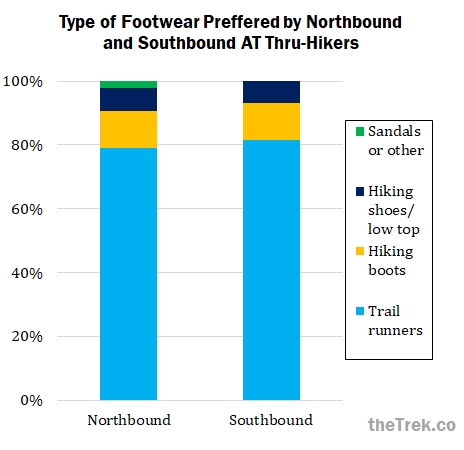
Southbounders’ Favorite Footwear Brands
Salomon and Altra were clear front-runners (no pun intended) as the most popular brands for footwear across both NOBOs and SoBos. No brand preferences were statistically significantly different for NOBOs versus SOBOs, although I’m sure that’s in part because we have a small sample. Merrell appeared more popular for SOBOs than NOBOs, while Brooks was more popular among NOBOs than SOBOs.
Hiking Without a Stove
Neither northbounders nor southbounders were more likely to choose, ultimately, not to carry a stove. In fact, for both NOBOs and SOBOs, many more started with a stove than finished with a stove. This suggests that the choice not to carry a stove is not necessarily due to seasonal/temperature changes throughout a thru-hike, but to other personal preferences.
For the past four years, I have been wondering if the trend of fewer stoves at the end than the beginning was just because our annual surveys are mostly comprised of northbounders. So while the difference doesn’t seem to be due to the direction/season of the hike, it’s interesting to see that thru-hikers going either direction tend to discard stoves by the end of their hikes.
Thru-Hike Completion Time
On average, southbounders took less time to complete their thru-hikes than did northbounders.4 I might have assumed this was due to southbounders having more experience, but even controlling for that, northbounders took longer. The average thru-hike duration for southbounders was 152 days +/- 96 days. For northbounders, the average thru-hike duration was 170 days +/- 60 days.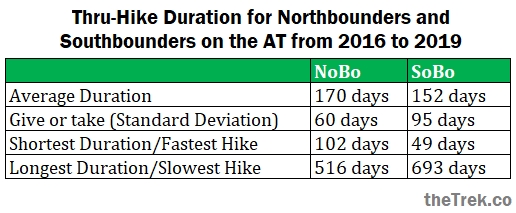
Hiking Solo
Neither NOBOs nor SOBOs were significantly more likely to start out their hike by themselves.5 For both groups, roughly two-thirds of hikers began alone. However, SOBOs were much more likely than NOBOs to spend the majority of their hike by themselves.6 One-quarter (25%) of southbounders spent the majority of their hike solo, whereas less than half that (7%) of northbounders spent the majority of their hike alone.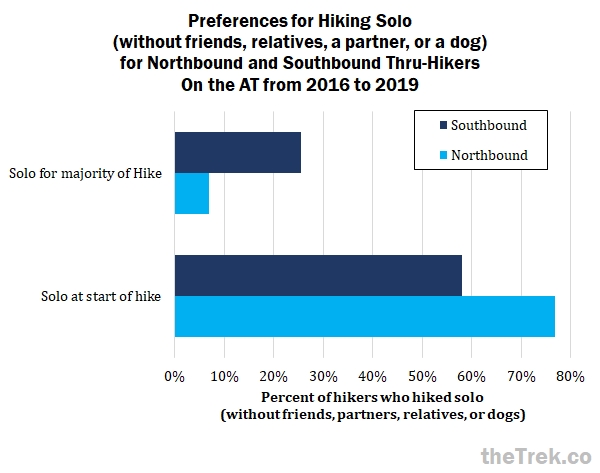
Southbounders’ Favorite Sections of the Trail
For both NOBOs and SOBOs, the White Mountains National Forest in New Hampshire was the most favorite section of the AT. Northbounders were more likely than SOBOs to say North Maine/the 100-Mile Wilderness and Baxter State Park were their favorites. Of course for NOBO hikers finishing at Katahdin, these areas are particularly meaningful AND these hikers are more fit by the time they reach this area, compared to most SOBOs. I assumed SOBOs would have more favorite spots on the southern AT or would rate the Southern Terminus more highly than NOBOs did, but this was not the case. Part of the issue is that SOBOs simply did not rate as many regions as NOBOs did. SOBO hikers still preferred northern areas of the AT, but they liked southern Maine more than Baxter State Park and the 100-Mile Wilderness.
Southbounders’ Most Difficult Sections of the Trail
Like with favorite sections, SOBOs did not rate as many “most difficult” sections as NOBOs did. The only section that SOBOs rated as more difficult than NOBOs did was the 100-Mile Wilderness in northern Maine. Many more NOBOs rated the Smokies and northern Pennsylvania as hardest, compared to SOBOs. Many NOBOs face snow in the Smokies, while this is more unusual for SOBOs unless they hike into December.
Future Survey Directions
There are other questions about differences based on direction of thru-hike that we were not able to answer with the survey data we already have. Mainly, I hope that in the next few years, we have enough data on flip-floppers to do a similar post about flip-flop trends. Comment below with questions you’d like to see answered in a future post on flip-floppers.
Among ourselves, The Trek editors and I wondered if SOBOs are more likely to quit because the trail is too hard early on. Or are they more likely to finish since doing a SOBO hike requires more planning ahead? We can’t answer this because we only asked thru-hikers the direction of their hike, not section hikers. However, according to the ATC, SOBOs have a higher dropout rate than NOBOs or flip-floppers.
If you would like updates on a future flip-flop post or on our annual hiker surveys, subscribe to The Trek newsletter.
TL;DR
- Slightly fewer southbounders replace their sleeping bags/quilts compared to northbounders
- Northbounders are more likely to swap out bags/quilts seasonally than southbounders
- The top quilt brand is the same regardless of hike direction, but northbounders chose REI more and southbounders chose Marmot more often.
- Average pack base weight is about the same for northbounders and southbounders: about 18 to 20 pounds.
- Preferred type of footwear type is the same for northbounders and southbounders: trail runners are more popular than hiking boots for thru-hikers, regardless of the direction of the thru-hike.
- The top footwear brands are the same for northbounders and southbounders, but southbounders chose Merrell more and northbounders chose Brooks more often.
- The choice not to carry a stove is not necessarily due to seasonal/temperature changes throughout a thru-hike, but to other personal preferences. This is because nearly all northbounders and southbounders started with a stove and about 45% finished without one, regardless of hike direction.
- On average, southbounders took less time to complete their thru-hikes than did northbounders.
- Roughly two thirds of hikers began alone, regardless of hike direction. However, southbounders were much more likely than northbounders to spend the majority of their hike by themselves.
- Northbounders were more likely than SoBOs to say North Maine/the 100-Mile Wilderness and Baxter State Park were their favorites. Southbound hikers still preferred northern areas of the AT, but they liked southern Maine more than Baxter State Park and the 100-Mile Wilderness.
- The only section that SOBOs rated as more difficult than NOBOs did was the 100-Mile Wilderness in northern Maine.
Thank you!
CONGRATULATIONS again everyone who completed a thru-hike from 2016 onward. Many thanks to those who participated in the survey. To the southbounders and especially those who were still hiking when they took the survey, thank you for taking the time to do that. I am also grateful to Zach Davis and Maggie Slepian for their assistance with the surveys and this post.
Notes for the Nerds
- McNemar’s χ2 = 3.704, df = 1, p = 0.054.
- Paired samples t-test was conducted. t = 1.421, df = 41, p = 0.163, 95% CI = . I also tried the Wilcox Signed Rank t-test which does not assume normality and had very similar results: V = 517, p-value_ = 0.152.
- McNemar’s χ2= 0.167, df = 1, p = 0.683.
- Wilcox Signed Rank test V = 481, p = 0.007.
- McNemar’s χ2 = 2.722, df = 1, p = 0.099.
- McNemar’s χ2 = 4.083, df = 1, p = 0.043.
This website contains affiliate links, which means The Trek may receive a percentage of any product or service you purchase using the links in the articles or advertisements. The buyer pays the same price as they would otherwise, and your purchase helps to support The Trek's ongoing goal to serve you quality backpacking advice and information. Thanks for your support!
To learn more, please visit the About This Site page.

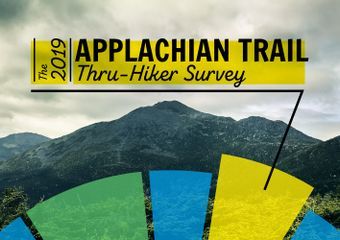

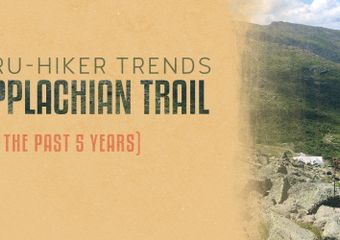

Comments 4
I completed a SOBO ( w/ 2 Flip Flops) in 2016 – 2017. I was 61 yoa and started at the NY/ CT line on 5/13/16.
Survey is very interesting and I am particularly interested in what was thought to be the most difficult part of the Trail. For me, hands down, the toughest part was Mt Washington to Andover, Me. The Mahoosuc Notch is fun when you’re 35, but just part of a meat grinder when you’re 60.
Favorite parts? How about Rockfish Gap to Pearisburg in Virginia. Woods Hole Hostel will always be a big favorite of mine.
By my calculations, I hiked for 179 days (took the winter off). It was the hardest sustained thing I ever attempted. High points were: hiking with my son in Maine (Katharin to Andover);, hiking with a buddy from Andover to Mt Washington;meeting “Skip”) in the Whites with whom I hiked to Hanover; hiking the Smokies with Doug & Martina of NJ; hiking to the Georgia line with a USMC captain; and meeting my wife at Neels Gap.
Trip of a lifetime. So much respect for all who take it on.
I’m trying to understand the “Favorites” and “Most Difficult” charts. It looks like the 2 groups are being compared in terms of absolute numbers, but there are more NOBOs than SOBOs. Wouldn’t it make more sense to compare by percentage of respondents than the absolute numbers given that the groups are unequal in size? And what does the “out of 43” refer to? The way I read it, it sounds like it is supposed to be 43 NOBOs vs. 43 SOBOs, but if you add them up, you get a lot more than 43 in each group.
As I describe in the earlier section “The Sample of Hikers”, I used a match sample of NoBos. Since we had 43 total 43 SoBos, I compared them to 43 similar NoBos in the analysis (the rest of the NoBos were not analyzed in this post). As I describe before the favorites graph, “Part of the issue is that SOBOs simply did not rate as many regions as NOBOs did.” Hikers rated all sections and could pick as many favorites as they wanted to.
I’m currently preparing / planning my SOBO AT thru hike for next year 2021. Had originally planned it for this year (would have turned 50 on the trail), but Covid and my appendix decided not to let me go. I’m an experienced backpacker, but I know i have lots of questions on planning this hike. One of the biggest is the cost, and making sure i am financially prepared for the hike. When you estimate costs for hiking the trail (say $5,000) what is that for ? I am guessing this is estimated costs for your daily meals, lodging when you have zero days, maybe transportation ? not sure. in that budgeted amount, is that a percentage for cost of gear that breaks down, or you have to replace, ie shoes…? Really enjoy reading your articles !
thanks,
scott